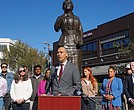Eyes on the prize
Editorial
12/6/2019, 6 a.m.
We find it interesting that the Richmond School Board, with all of its talk about the importance of equity and diversity, backed away from a school pairing plan when it approved new school attendance zones at its meeting this week.
The issue of school integration has been a thorn in the side of Richmond Public Schools for decades that led to the tumultuous “busing” years in the 1970s; “white flight” as scared white parents pulled their children out of RPS for fear they would have to share classrooms, lunchrooms, locker rooms and bathrooms with black children; and later “school consolidation,” with the city’s high schools paired into complexes, such as the “Marshall-Walker” complex.
During the recent bevy of school rezoning meetings and public hearings, we felt a sense of déjà vu, although, fortunately, the discussions were without the rancor and overt racist remarks that marred the ’70s busing debate.
While the current language surrounding the plans is different from the past, some of the concepts are the same: School pairings of elementaries with majority African- American student populations with elementaries with majority white student populations — like the complexes of the past — and more “open enrollment” for students to attend schools anywhere in the city.
Open enrollment is like the old pre-busing “freedom of choice” policy that gave residents the “freedom” to send students to whatever school in the city they wanted. However, it turned out to be a negative experience for some of those black students who were removed from their underfunded and often neglected black schools only to suffer abuse and trauma as “the first” to integrate white schools where their presence was neither welcomed nor embraced.
We understand that consciousness has changed to a degree since then. But what was clouded in the dust-ups in the past should remain paramount in the discussions and deliberations of today — and that is equity in our schools.
School desegregation was not pushed simply to allow black students to sit in a classroom with white students. It was to help alleviate and ameliorate the decades of neglect and lack of public dollars and other resources going to black schools and the education of black children. By spreading black and white children around equally to all schools, the thought was the resources would be spread around, too, giving all students an equal education.
While that concept may have been admirable, the outcome has fallen short as evident by RPS’ continuing achievement gap between African-American, white and Latino students.
We hope that the rezoning plan the School Board adopted Monday night will be sufficient to meet the goals for diversity expressed by the board and school administration. But we believe it is paramount for the board, RPS Superintendent Jason Kamras and the school administra- tion to continually examine and address the inequity in resources to city schools that perpetuate the achievement gap. That includes fixing the decrepit conditions of the aging schools that hamper students’ learning. That means adding staffing and programs to address barriers to learning, as well as the social and emotional barriers to learning arising from poverty that affect roughly three out of four RPS students.
All of that adds up to the need for more dollars from the state and the city to support RPS.
Making the right moves is critical now for RPS and for the future of our children, including protecting RPS funding from any future cutbacks because of a 30-year funding scheme for the proposed Coliseum replacement and Downtown development project that would stymie taxpayer dollars to the city’s general fund and support for schools for the next 30 years.
We believe RPS is on the right road with its new trauma-informed training and practices guiding teachers and the education process. And Dreams4RPS, the school system’s strategic plan through 2023, is a positive guide for increasing equity and quality in city schools.
But more importantly than who sits next to whom in the classroom is that Richmond students are in heated, lighted, functioning, well-resourced and not overcrowded classrooms with well-trained teachers, counselors, aides, electronics, learning and support tools and opportunities to achieve, graduate and excel in the future.
We hope that the School Board, along with the hundreds of parents who turned out for the zoning meetings, will keep their eyes on this greater prize — for more funding and equity for a first-class education for all students in Richmond Public Schools.






